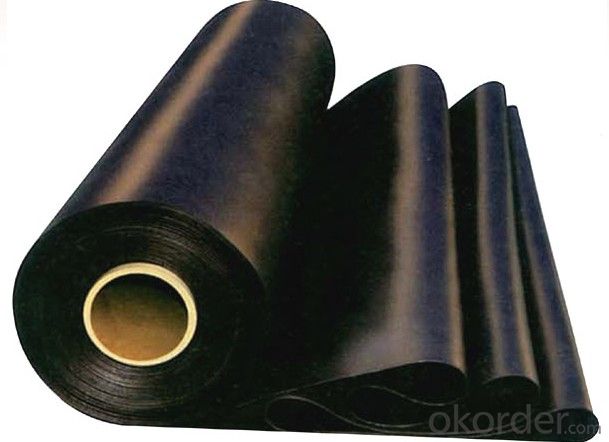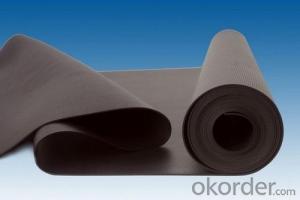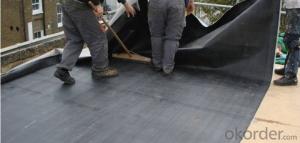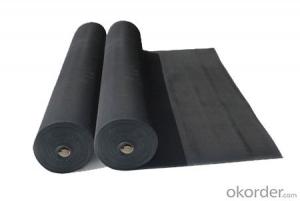EPDM Waterproofing Membrane for Construction
- Loading Port:
- China main port
- Payment Terms:
- TT OR LC
- Min Order Qty:
- 5000 m²
- Supply Capability:
- 100000 m²/month
OKorder Service Pledge
OKorder Financial Service
You Might Also Like
Introduction for EPDM Waterproofing Membrane:
EPDM (TBD) self adhesive rubber waterproofing membrane is used (OP) rubber waterproofing membrane as based materials, Surface coating Nano-polymer adhesive glue squeeze a new high-strength self adhesive waterproofing.
Characteristic of EPDM Waterproofing Membrane:
1>Excellent anti-aging performance, service life up to 50 years
2>Working well with in -40°C to 100°C,it can be constructed with a single layer in ambient temperature. 3>Waterproofing on various kinds of underground project,industrial of civil buildings and structures. 4>high extension rate, high tensile strength, small size changes at heat treatment
5>Good plant roots penetrability resistance and can be made waterproofing layer of planting roof
6>Special modified molecular structure ,effectively resolving the current domestic and foreign glue joint problem . 7>Good low temperature flexibility, and good performance of adapting to ambient temperature changes. 8>Convenient application ,solid joint, no environment pollution
9>chemical corrosion Resistance, can be used for special occasions
Application Range of EPDM Waterproofing Membrane:
EPDM (TBD) selfadhesive waterproofing membrane used in roofing projects, exposed roofing, building foundations, basements, storage tanks, subways, tunnels, supermarkets, airports and other buildings waterproof.
Item | Thickness(mm) | Width(mm) | Length(m) | Color |
1.0—2.0 | 1200 | 20 | Black | |
Deviation | -1 +15 | --1 | Multicolor |
FAQ of Waterproofing Membrane
a.Can we get some samples before place order?
Answer: We can send the free samples to you by freight collect.
b.How many years can your PVC membrane guarantee?
Answer: We will guarantee the quality for 5 years at least.
c.Which countries you ever export the product?
Answer: We export the PVC membrane to South Africa, Middle east and even European countries.

- Q:Can a waterproofing membrane be used on zinc surfaces?
- Yes, a waterproofing membrane can be used on zinc surfaces. Zinc is a durable and corrosion-resistant material commonly used in various applications, including roofing and cladding. Applying a waterproofing membrane on zinc surfaces can provide an additional layer of protection against water intrusion and moisture damage. It can help prevent leaks, extend the lifespan of the zinc surface, and maintain its overall integrity. However, it is important to ensure that the waterproofing membrane is compatible with zinc and specifically designed for such applications. It is recommended to consult with a professional or manufacturer to determine the best waterproofing solution for zinc surfaces.
- Q:How does a waterproofing membrane withstand freeze-thaw cycles?
- A waterproofing membrane withstands freeze-thaw cycles by being designed with materials that can expand and contract without losing their integrity. These membranes are typically made of rubber or synthetic polymers that are flexible enough to accommodate the expansion and contraction caused by freezing and thawing temperatures. Additionally, they are formulated to resist water penetration even when subjected to these cyclical temperature changes, ensuring their effectiveness in preventing water damage.
- Q:Are there any specific considerations for installing a waterproofing membrane on precast concrete surfaces?
- Yes, there are specific considerations for installing a waterproofing membrane on precast concrete surfaces. Here are a few key points to keep in mind: 1. Surface Preparation: Before applying the waterproofing membrane, it is crucial to prepare the precast concrete surface properly. This may involve cleaning the surface, removing any loose particles, and ensuring that it is dry and free from any contaminants. 2. Compatibility: It is important to choose a waterproofing membrane that is compatible with precast concrete surfaces. Some membranes may not adhere well or may not provide effective waterproofing on this type of substrate. Therefore, it is essential to select a membrane specifically designed for use on precast concrete. 3. Adhesion: Ensuring proper adhesion of the waterproofing membrane to the precast concrete surface is vital. The manufacturer's instructions should be followed carefully, including any surface priming or preparation requirements for optimal adhesion. Proper adhesion will help prevent any water infiltration or damage to the concrete. 4. Joint Treatment: Precast concrete surfaces often have joints between panels or other components. These joints need to be properly treated to maintain the waterproofing integrity of the system. This may involve using joint sealants or tapes specifically designed for waterproofing purposes. 5. Durability: Consider the durability and longevity of the waterproofing membrane. Precast concrete surfaces are often exposed to various weather conditions and environmental factors. Therefore, it is crucial to select a membrane that can withstand these conditions and provide long-term protection against water penetration. 6. Quality Assurance: It is recommended to work with experienced professionals or certified installers to ensure the proper installation of the waterproofing membrane on precast concrete surfaces. This will help to minimize any potential installation errors and ensure that the waterproofing system performs as intended. By considering these specific considerations, the installation of a waterproofing membrane on precast concrete surfaces can help protect the concrete from water damage and extend its lifespan.
- Q:Does a waterproofing membrane prevent water damage to building materials?
- A waterproofing membrane is specifically designed to shield building materials from water damage. Its purpose is to act as a barrier, preventing water from infiltrating the structure and causing harm. Typically, the membrane is applied to areas prone to water intrusion, such as roofs, basements, and foundations. By creating a watertight seal, it effectively stops water from seeping through and harming the building materials. This safeguard is essential in maintaining the structure's integrity and preventing issues like mold growth, rot, and material decay. However, it's crucial to acknowledge that the effectiveness of a waterproofing membrane can vary based on the product's quality and proper installation. Regular maintenance and inspections are also necessary to ensure the membrane remains intact and continues to safeguard against water damage.
- Q:Can waterproofing membranes be used on terraces?
- Yes, waterproofing membranes can be used on terraces to prevent water penetration and protect the underlying structure from moisture damage.
- Q:How does a waterproofing membrane handle freeze-thaw cycles?
- The ability to endure freeze-thaw cycles is a crucial characteristic of a waterproofing membrane. It must possess specific properties that allow it to expand and contract without compromising its integrity. Freeze-thaw cycles occur when water enters the membrane and freezes during colder temperatures, causing it to expand. When the ice melts during warmer temperatures, the membrane should be able to contract back to its original state. In order to handle freeze-thaw cycles, a waterproofing membrane typically possesses elasticity and flexibility. This enables it to adjust to the expansion and contraction without cracking or breaking. It may also have a low water absorption rate to prevent water from seeping into the membrane. Moreover, the membrane should exhibit excellent adhesion to the substrate to ensure it remains in place during temperature fluctuations. Certain waterproofing membranes incorporate special additives or technology to enhance their freeze-thaw resistance. These additives may consist of polymers or elastomers that enhance the membrane's ability to withstand extreme temperature changes. Furthermore, some membranes have reinforced layers or fabric inserts that provide additional strength and durability, making them better equipped to handle freeze-thaw cycles. All in all, a well-designed waterproofing membrane should effectively endure freeze-thaw cycles by possessing elasticity, flexibility, resistance to water absorption, and strong adhesion to the substrate. This guarantees the longevity of the membrane and prevents water infiltration, ultimately protecting structures from potential damage caused by freeze-thaw cycles.
- Q:Can a waterproofing membrane be used for hospitals or healthcare facilities?
- Yes, a waterproofing membrane can be used for hospitals or healthcare facilities. Waterproofing membranes are commonly used in these types of buildings to protect the structure from moisture damage and prevent water leakage, which is crucial for maintaining a safe and hygienic environment. The waterproofing membrane helps to create a barrier against water infiltration, ensuring the longevity and integrity of the building and safeguarding the health and well-being of patients and staff.
- Q:The shortcomings of polypropylene waterproofing, and the shortcomings of modified asphalt waterproofing membrane
- Waterproofing membrane in the waterproof construction in accordance with the shape of the waterproof base of the bulk of the truncated, for the complex shape of the grassroots need to multi-block splicing, waterproofing membrane overlap at each other more difficult, due to the impact of multi-block splicing waterproof Layer of beauty; then completely completely sealed will become the main problem, the biggest hidden dangers, the most opportunities is the coiled parts of the coil; then high-grade waterproofing membrane with decades of durable durability,
- Q:Can a waterproofing membrane be used in crawlspaces or basements?
- Yes, a waterproofing membrane can be used in crawlspaces or basements. In fact, it is highly recommended to use waterproofing membranes in these areas to prevent moisture infiltration and water damage. Crawlspaces and basements are prone to water seepage and high humidity levels, which can lead to mold growth, structural issues, and damage to stored items. A waterproofing membrane acts as a barrier against water intrusion by effectively sealing the foundation walls and floor. It creates a watertight seal that prevents water from seeping into the space, keeping it dry and protected. Additionally, waterproofing membranes also help to control moisture levels by reducing condensation and humidity, thereby creating a healthier and more comfortable environment. Overall, using a waterproofing membrane in crawlspaces or basements is an essential measure to ensure the longevity and integrity of the structure and to safeguard against potential water-related problems.
- Q:Can waterproofing membranes be used on mechanical rooms?
- Yes, waterproofing membranes can be used on mechanical rooms. Mechanical rooms often house equipment such as boilers, pumps, and ventilation systems, which can be sensitive to water damage. Waterproofing membranes provide a protective barrier against water infiltration and can help prevent leaks, moisture buildup, and potential damage to the equipment. Additionally, these membranes can also provide thermal insulation, noise reduction, and fire resistance properties. It is important to choose the appropriate type of waterproofing membrane based on the specific needs and requirements of the mechanical room.
1. Manufacturer Overview |
|
|---|---|
| Location | |
| Year Established | |
| Annual Output Value | |
| Main Markets | |
| Company Certifications | |
2. Manufacturer Certificates |
|
|---|---|
| a) Certification Name | |
| Range | |
| Reference | |
| Validity Period | |
3. Manufacturer Capability |
|
|---|---|
| a)Trade Capacity | |
| Nearest Port | |
| Export Percentage | |
| No.of Employees in Trade Department | |
| Language Spoken: | |
| b)Factory Information | |
| Factory Size: | |
| No. of Production Lines | |
| Contract Manufacturing | |
| Product Price Range | |
Send your message to us
EPDM Waterproofing Membrane for Construction
- Loading Port:
- China main port
- Payment Terms:
- TT OR LC
- Min Order Qty:
- 5000 m²
- Supply Capability:
- 100000 m²/month
OKorder Service Pledge
OKorder Financial Service
Similar products
New products
Hot products
Hot Searches
Related keywords



























